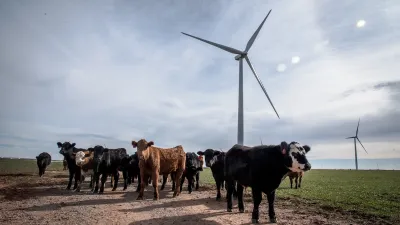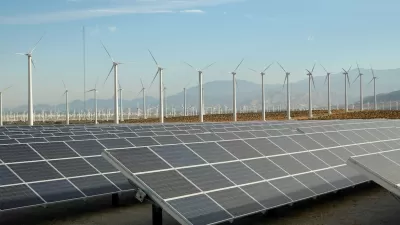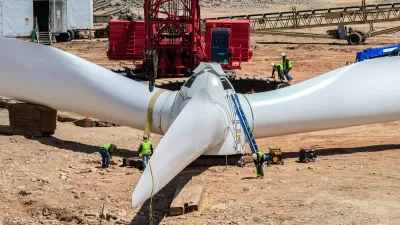The production of renewable energy in the United States is on track to surpass other energy sources this year, but the nation must maintain record high production levels to meet its climate goals.

Renewable energy sources like solar and wind will likely generate more power than coal and nuclear plants in the United States this year, reports Benjamin Storrow in Scientific American. According to Storrow, “Wind and solar output are up 18 percent through Nov. 20 compared to the same time last year and have grown 58 percent compared to 2019, according to the U.S. Energy Information Administration.”
But doubts remain whether the growth of renewables will meet the 40 percent emissions reduction goal by 2030 set by the Biden administration. As Storrow explains, “Supply chain constraints and trade disputes have slowed wind and solar installations, raising questions about the United States' ability to meet the emission reductions sought by the Inflation Reduction Act.”
Despite the hundreds of billions invested in clean energy by the Inflation Reduction Act, it will take time to implement the new law and get new funding out to projects. “Tax guidance needs to be finalized before developers begin plunking down money on new facilities, and companies now face headwinds in the form of higher interest rates and the looming threat of a recession.” Meanwhile, renewable energy production must maintain record growth. “Researchers at Princeton University estimate the country needs to install about 50 gigawatts of wind and solar annually between 2022 and 2024, or roughly double the 25 GW that the United States installed annually in 2020 and 2021.”
FULL STORY: U.S. Renewable Energy Will Surge Past Coal and Nuclear by Year’s End

Maui's Vacation Rental Debate Turns Ugly
Verbal attacks, misinformation campaigns and fistfights plague a high-stakes debate to convert thousands of vacation rentals into long-term housing.

Planetizen Federal Action Tracker
A weekly monitor of how Trump’s orders and actions are impacting planners and planning in America.

Chicago’s Ghost Rails
Just beneath the surface of the modern city lie the remnants of its expansive early 20th-century streetcar system.

Bend, Oregon Zoning Reforms Prioritize Small-Scale Housing
The city altered its zoning code to allow multi-family housing and eliminated parking mandates citywide.

Amtrak Cutting Jobs, Funding to High-Speed Rail
The agency plans to cut 10 percent of its workforce and has confirmed it will not fund new high-speed rail projects.

LA Denies Basic Services to Unhoused Residents
The city has repeatedly failed to respond to requests for trash pickup at encampment sites, and eliminated a program that provided mobile showers and toilets.
Urban Design for Planners 1: Software Tools
This six-course series explores essential urban design concepts using open source software and equips planners with the tools they need to participate fully in the urban design process.
Planning for Universal Design
Learn the tools for implementing Universal Design in planning regulations.
planning NEXT
Appalachian Highlands Housing Partners
Mpact (founded as Rail~Volution)
City of Camden Redevelopment Agency
City of Astoria
City of Portland
City of Laramie





























